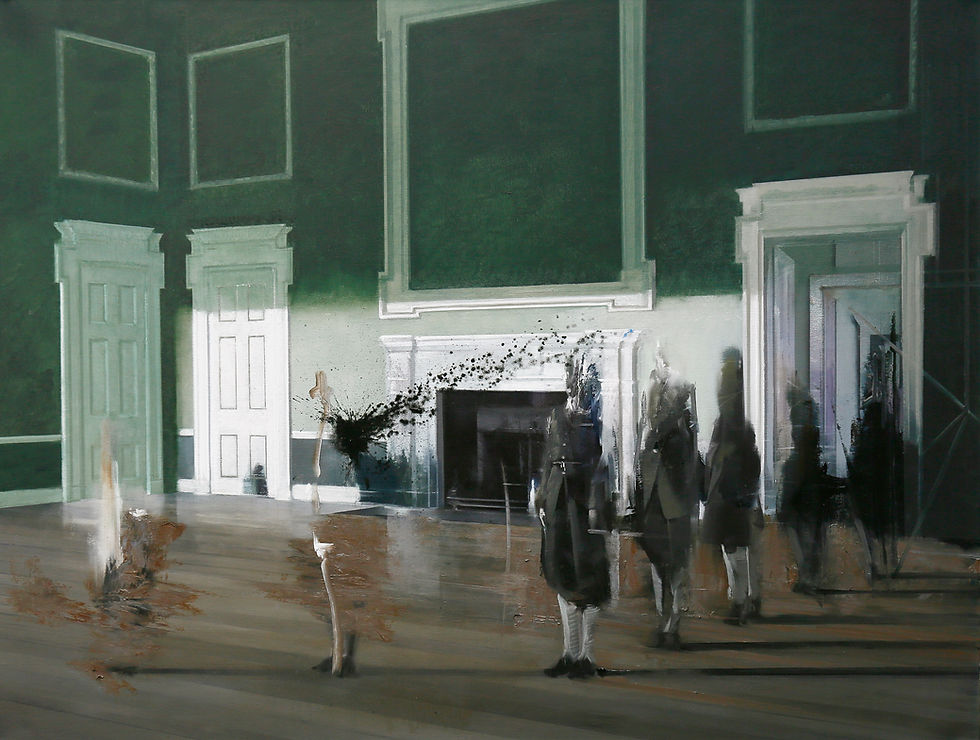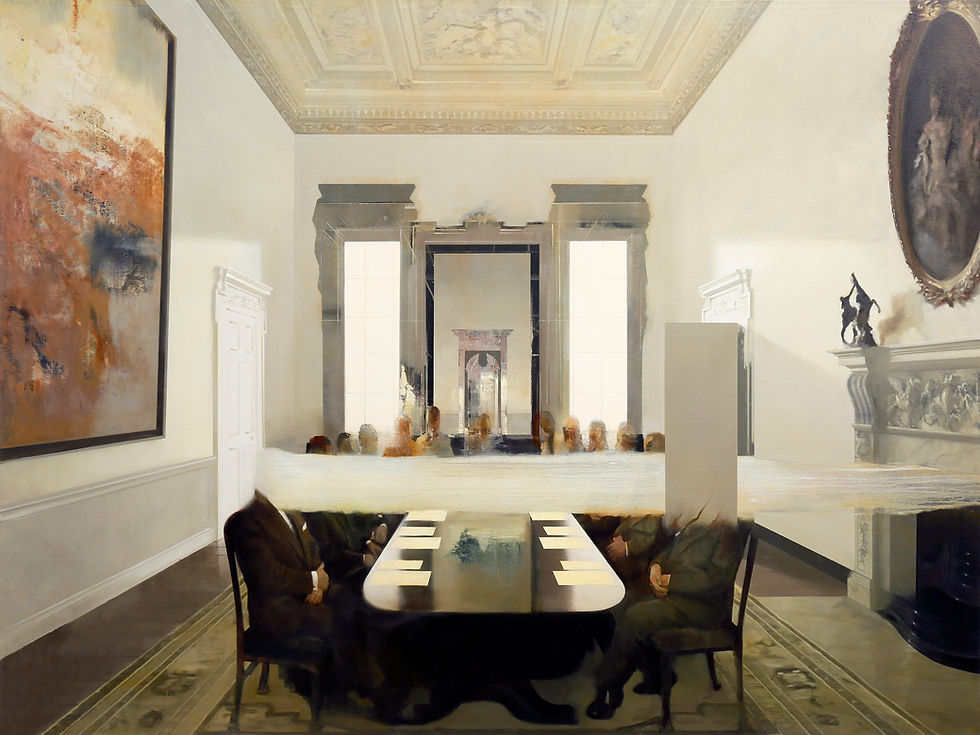"YOU DON'T REBUILD HISTORY, YOU MODIFY IT": TIM KENT'S 'HISTORIES IN FLUX' AT JD MALAT GALLERY
- Joanna Metodieva
- May 13, 2024
- 6 min read
Updated: May 21, 2024
Based in Mayfair, JD Malat Gallery recently presented Histories in Flux, a collection of new works by Tim Kent. As a first-generation American with British heritage, Kent is familiar with the UK. He completed his painting degree at West Dean College, where he discovered inspiration within the world of historical interiors. Kent's figurative paintings explore history while challenging conventional narratives, offering perspectives on the dynamic relationship between past and present. His works, such as Procession (2024), prompt viewers to question the dystopian figures placed within beautiful historical interiors, evoking conflicting interpretations, constructing psychologically charged environments that encourage discourse around the complexities of our world, including class, access, privacy, and consumption. I recently had the privilege of speaking with Kent to discuss the hidden narratives within his paintings and the influences behind these complex pieces.
Installation image courtesy of JD Malat Gallery
Tim, could you start by telling me a bit about yourself and your background? Where does your interest in history begin?
I think I probably have an interest in history because growing up I was never in one place long enough. And then I know there are notions of my family history: my mother's family, they're very proud of being British and my father's family, which is Turkish, they were farmers and became business people. And they’re cultured in a different sense than the British, for example, they have all this ancient statuary that’s all in ruins.
So, I also thought a lot about that recently. It's like, as a kid going over there and seeing all these ruins, it was romantic. To see these fantastic old cities. This is before they rebuild these places for tourism. And there's a mystery to it. I think that's kind of one of the reasons why I got into history. That there have been civilizations for thousands of years before us in these places.

Tim Kent, Menagerie, 2024
How did your perception of history shape your latest show Histories in Flux?
If one looks back through the history of the world, there's always been polarisation. In the modern world where we once got most of our information from newspapers, one’s view depended on which newspaper you read. But the level of polarisation that began happening through social media is unprecedented, now you have this confluence of information cross-checking and bouncing and negating each other.
And so the idea for the work started in about 2018, where I started thinking about technology and started making images around technology, but that didn't really satisfy me. And so I began connecting more the way in which history gets reinterpreted over time. So there isn't a singular truth.

So, you believe that history isn't fixed but rather fluid and subject to interpretation?
There isn't a singular narrative to history. And that was being pointed out by so many people. I mean, you know, the famous Edward Said's Orientalism (1978), Franz Fanon's The Wretched of the Earth (1961): these are books which challenge these sorts of notions. And that's kind of how the historical thing began playing into all the material that I already had.
How do you envision your work contributing to the discourse of history and its interpretation?
You know when you go to an art gallery, like the Louvre? You look at hundreds of paintings and they all look the same. Occasionally you see a piece and you're like, ‘oh, that's really interesting and I'll spend a minute with it’. I kind of feel like I want my paintings to have that sort of boringness to them, so that when you do look at them, you begin seeing the inconsistencies.
I picked a very traditional style to work in because I like the banality of it. And the banality leads to the investigation, in a sense. You kind of take it for granted and all of a sudden you look and you're like 'wait, that's not right'. It looks familiar, but it's not. And so then you're looking; the important thing is to look. I can look at an abstract painting and get lost in it. Very rarely do I get lost in figurative work, but I want to use the expected norms of art historical styles to present inconsistencies.

Mentioning the Louvre and wider Art History, how would you say the traditional institution plays part in your artistic exploration?
I think in the West, we have the grand narrative of, you know, Egypt to Rome, to the Middle Ages, to the Renaissance, to Enlightenment, to Modernism, to now and there's those big stories. You get the big heroes. But of course, as you get alternate narratives of history, you're finding out that the stories told about these artists are so pumped up that they become larger than life, and their work becomes more important than it is. And I'm interested in the histories of the people that [aren't the big heroes]. Are they invisible people within that structure? I like the idea of the workers of art. I love the idea of people who set things up on the wall, the people who are actually making this sort of world exist for the sake of itself. So, you see a lot of people in my paintings who are working around art.
You mentioned there isn’t a singular truth about history, would you say your work also explores multiple narratives that are in a way conflicting?
Yeah, I hope they fall apart to do that. I hope the messaging is confusing, because I want to put symbols in there that are very generic, but they're conflicting as well.
Your use of symbols and imagery is particularly intriguing. Can you tell me more about the recurring motifs in your works, such as the distorted horse sculptures?
There's a lady I know in New York, and she told me about her project called The Toppled Monuments Archive. She sees [monumental statues] as fallacies and part of the colonial ideological doctrine. And I was like, you know, that's kind of really cool.
I don't necessarily agree that they should be destroyed. I understand the symbolic need to do that, but at the same time, I almost feel like they should be modified somehow. And so the way I thought about modifying it was I made a model and then I wrapped it in material. Then I need[ed] something in this painting that kind of turns that power relationship upside down. So I started using this horse, and it just kind of got into these paintings. For for me, it's recognising this idea of turning narratives of history upside down. I don't think you rebuild history, I think you modify it. And so these are modifications to the narrative.
From left to right: Tim Kent, Muniments II | Archive II, 2023
The symbolic narratives in your work usually unfold in historical architectural spaces, how do you approach and what is the importance of interior space in your work?
I really wanted to be a figurative painter. This is when I was starting out: I wanted to do people. And then I realised that in order to paint the people, I had to paint the spaces that they were in. And as I began painting the spaces that they were in, I realised that you don't need the people to tell the story. So I started painting a lot of empty spaces because the space itself does its own work.
Could you take me through your creative process when developing these psychologically charged spaces in your artwork, such as Procession (2024)? What were the inspirations behind this particular piece?
When I was studying at West Dean, Sussex I started painting these rooms of West Dean itself, which is this old eighteenth century manor house. At first, I didn't know if I could take photographs. So, I used to draw a lot of these spaces. And then, I was like, why don't I just take a digital camera with me? It was the first time I started using photography in my work. I began to integrate the photography into my perspective drawings.
Installation image courtesy of JD Malat
I have this vast catalogue of houses I visited; some of these are completely empty. I love empty rooms that are glorious and romantic, where you feel a history to them. Because I can always imagine what the history is, even if it's wrong.
I like the idea of these figures that somehow belong to the space in a historical way, but also are not there. There's a question of who are these people? What are these people? I had to figure out some way to get the idea of a time movement. So, I thought about it almost like a pendulum clock swing and at the end of that, where that figure is exploding is that critical moment where it swings back again. That's what I was thinking about: the procession of time.
Joanna Metodieva is a London-based contemporary art writer, exploring the intersection of creativity, culture, and society.










